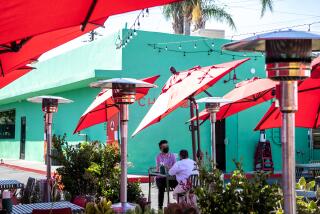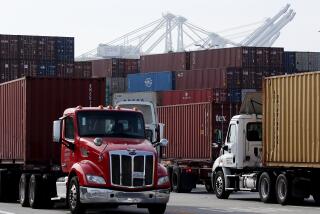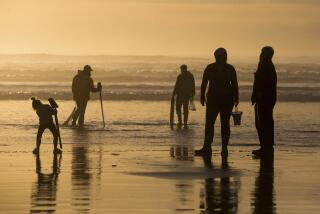Lobster Industry Lauds Permit Tightening : Fisheries: Only renewal licenses will be issued for the next two years. Fishermen expect the move to slow an onslaught of newcomers competing for the catch.
DANA POINT — A new two-year moratorium on commercial lobster fishing permits imposed by the California Fish and Game Commission is welcome news at Dana Point Harbor’s bustling lobster fishing dock, where competition has grown fierce for the pricey crustaceans.
Under the new rules, which went into effect Nov. 2, no new commercial fishing licenses will be issued for two years. Lobster fisherman who hold permits will be allowed to renew them annually.
“Right now, if you don’t already have a permit, you can’t go out and buy one,” said Dave Parker, senior biologist for the Department of Fish and Game. “Next year you won’t be able to get one as well.”
Recreational lobster fisherman, who operate with a $12 annual fishing license and have a limit of seven lobsters a day, will not be affected, Parker said.
Because most restaurants do not sell local lobsters, the new rules are not expected to affect menu prices, restaurant owners say. At the Wind & Sea Restaurant, across from the Dana Point Harbor lobster dock, owner Robert Mardian sells only Australian lobster tails.
“The Australian lobster comes to us frozen, but it’s consistent in size and taste,” said Mardian, who owns four restaurants in California and Hawaii. “The California lobster is good fresh, but for some reason it doesn’t have the shelf life.”
Restaurateurs who do offer local lobsters say they have been concerned about increasing prices in recent years. But they keep local lobsters on the menu as a tradition to loyal customers who demand them.
“This year hasn’t been a good season. There is a short supply and the prices have gone up,” said John Hicks, owner of Harbor Grill, where local lobster has been on the menu for 10 years. “It has become more of a goodwill gesture on our part to serve it.”
For longtime fishermen such as Peter Tresselt of Laguna Beach, the commission’s decision was necessary to curb an onslaught of newcomers to lobster fishing, an annual $3.6-million industry in the state and California’s 11th-largest fishery. Tresselt, 60, who has fished the waters off Dana Point for 34 years, said he was a longtime opponent of limiting the number of permits, but recently has changed his mind.
“Philosophically, I hate to see business opportunities shut down to anybody,” Tresselt said. “This was traditionally one of the few businesses that a man without a lot of money could get into. But we became the only fishery in the state without restrictions on permits, so people who wanted to get into fishing were forced into lobstering.”
Increasing demand in Asia for California lobsters has led to higher prices at Southern California docks, luring more people into the industry.
Also, the recent ban on gill-net fishing along the California coast has encouraged more fishermen to turn to lobstering. Proposition 132, which banned gill netting within three miles of the coast, was approved by voters in 1990 and went into effect Jan. 1, Parker said.
Ever since the measure’s passage, representatives of the lobster industry, including the California Lobster and Trap Fishing Assn., have been lobbying Fish and Game officials for some kind of limit on permits, Parker said.
“There was a real concern that lobstering was the only option for a number of other fishermen who were being displaced,” Parker said.
Newcomers to the industry also are more likely to take lobsters smaller than the legal limit, a practice that harms the next year’s crop, said Roberta Corkill of Oceanside, secretary-treasurer of the association, which represents about 600 fishermen statewide.
The result can be seen this year in San Diego, where the catch to date is smaller than any other in recent history, Corkill said.
“They were being taken no matter what size they were,” she said.
The number of permits sold this year is not available, but Parker said that since 1980, 300 to 450 permits have been sold annually at $265 each. He said he expected the number of licenses issued this year to be greater if prospective fishermen learned that November was their last chance to secure one for the next two years.
Although the number of lobster fishermen may vary, the statewide lobster catch has stabilized at 500,000 to 600,000 pounds a year, Parker said. Nearly half the catch comes from the Channel Islands. San Diego, Oceanside, Dana Point, Los Angeles, Ventura and Santa Barbara are other major lobster fishing locales, according to Fish and Game statistics.
Tresselt said his catch off Dana Point has been typical. The first two months of the October-to-March season are generally the most productive. After that, the size of the catch depends on the weather, he said.
“When the water gets real clear, the lobsters tend to stay in the rocks and the catch just drops off to nothing,” Tresselt said. “But when we get some storms like we’ve had, it creates turbulence in the water and that’s when the lobsters go out and feed. That’s when we get them.”
More to Read
Sign up for Essential California
The most important California stories and recommendations in your inbox every morning.
You may occasionally receive promotional content from the Los Angeles Times.









